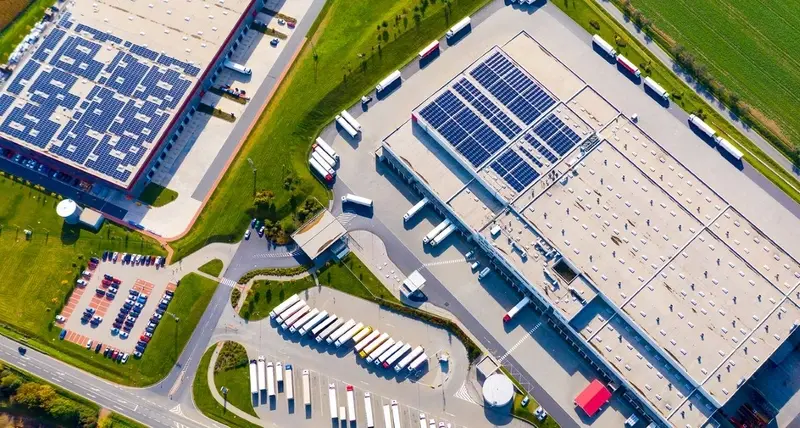
THIS IS AN ADVERTISING FEATURE
Craig Wright, head of European research, abrdn
There is a strong story to tell in the logistics and warehousing sector, which is likely to be an area of significant growth and development all over the globe in the years ahead, particularly in the UK and Europe.
E-commerce sales growth in Europe has been led by the UK, followed by the Netherlands, Czech Republic, Ireland and Poland. Investors now expect to see major e-commerce expansion in the coming years in Germany, Spain and France, as these countries see online sales capacity grow from a low base.
The Covid-19 pandemic gave e-commerce an artificial boost and although e-commerce spending has since dropped back to a more typical level, the growth rate is expected to remain significant. This means physical shops will continue to lose out to warehouses and the fleets of lorries and vans required as retailers deliver goods across the country to their customers’ doors. Smaller and more frequent purchases increase both the number of times goods are moved and the warehouse capacity required to process it all.
To sell the same amount of goods online as in-store, you need an estimated three times more logistics space. It’s not only about more floorspace; the capacity needs to be in different locations too, as an e-commerce-based retail platform needs a combination of big boxes, where bulk goods are stored, and local ‘last-mile’ urban logistics facilities. where goods are broken down, processed and shipped to the customer.
Urban logistics units are the newest part of the supply chain but are critical components. The higher prevalence of returns and the challenges of distributing to a fragmented customer base can only be efficiently serviced from bespoke warehousing. The warehousing space needs to be able to house specialist automated technology and cross docking functionality, to allow the rapid movement of goods to support ‘instant delivery’ aims.
Ideal locations are typically on the fringes of urban areas where efficiency is maximised, labour is available, and costs are kept to a minimum. Not surprisingly, demand for space like this is only increasing and vacancy rates across Europe are at historical lows. It’s likely that governments will have to intervene to ensure that cities get the logistics infrastructure they need without negative effects on the environment or employee working conditions.
The UK has been one of the fastest adopters of e-commerce for several reasons, including the rapid growth of Amazon. The smaller landmass of the UK and the number of densely populated areas mean Amazon has been able to create short delivery timescales and has taken more market share. In Europe, the expansion of Amazon has generally been slower, apart from in Germany. Spanish company, Il Corte Ingles, is one of many European businesses aiming to compete with Amazon domestically by improving its online sales capability and its supply-chain efficiency.
Distance and greater landmass can be a barrier in Europe, but as most e-commerce is centred around urban areas, more available land can make it easier for e-commerce companies to find sites. Cultural shopping habits, particularly around grocery shopping, and a lower appetite for fast fashion are perhaps greater barriers to e-commerce growth in some countries.
The demand for warehousing and logistics support is not just about e-commerce but is also driven by de-globalisation and the need for more local supply chains. ‘Friend shoring’ and ‘near shoring’ are terms we now hear, as countries consider their energy security, battery production and domestic supply chain networks, to reduce over-reliance on other countries. The growth of warehousing on the Mexico-US border is a good example of the US wanting to bring manufacture and supply closer to home. Real estate broker CBRE estimates that 40% of logistics leasing in Mexico was driven by near-shoring demand in 2022. The pandemic has changed supply chains from ‘just in time’ to ‘just in case’, plus long supply chains bring added risk and costs.
As investors in the warehousing and logistics sector, we aim to buy, or create, best-in-class assets with sound long-term prospects. Strong ESG credentials form an increasingly normal requirement for tenants and landlords. Yet most existing stock in Europe is over ten years old and not compliant with modern ESG standards. Landlords can dramatically improve their Energy Performance Certification (EPCs) by replacing gas heating with electric or geothermal heat and by installing photovoltaic cells on warehouses, though older properties are typically harder to modify. Landlords will need to adapt to these requirements and investors must be aware of them for existing assets and potential acquisitions.
The legislation is evolving quickly, and companies will be forced to adopt standards on emissions and employee welfare conditions. Operators should think ahead to ensure they are not regulated out of the very areas which also constitute the optimal location for their infrastructure.
During recent years, supply chains and infrastructure to service e-commerce have had to evolve at breakneck speed. It will likely take another decade or so before supply chains begin to meet modern demands. But we certainly see this as a major and ongoing trend that will not diminish now that the pandemic period is over.
Important information
Risk factors you should consider prior to investing:
- The value of investments and the income from them can go down as well as up and you may get back less than the amount invested.
- Past performance is not a guide to future results.
- Investment companies can borrow money in order to enhance investment returns. This is known as ‘gearing’ or ‘leverage’.
- However, the use of gearing can result in share prices being more volatile and subject to sudden or large falls in value. Where permitted an investment company may invest in other investment companies that utilise gearing which will exaggerate market movements, both up and down.
- There is no guarantee that the market price of the Company’s shares will fully reflect its underlying Net Asset Value.
- As with all stock exchange investments the value of the Company’s shares purchased will immediately fall by the difference between the buying and selling prices, the bid-offer spread. If trading volumes fall, the bid-offer spread can widen.
- Investing globally can bring additional returns and diversify risk. However, currency exchange rate fluctuations may have a positive or negative impact on the value of your investment.
- The Company may hold a limited number of investments. If one of these investments declines in value this can have a greater impact on the fund’s value than if it held a larger number of investments.
- Property values are a matter of the valuers’ opinions and can go up and down. There is no guarantee that property values, or rental income from them, will increase so you may not get back the full amount invested.
- Property investments are relatively illiquid compared to bonds and equities and can take a significant length of time to sell and buy.
- The Company invests in a specialist sector and it will not perform in line with funds that have a broader investment policy.
- Derivatives may be used, subject to restrictions set out for the Company, for efficient portfolio management in order to manage risk. The market in derivatives can be volatile and there is a higher than average risk of loss.
Other important information:
Issued by abrdn Fund Managers Limited, registered in England and Wales (740118) at 280 Bishopsgate, London EC2M 4AG. abrdn Investments Limited, registered in Scotland (No. 108419), 10 Queen’s Terrace, Aberdeen AB10 1XL. Both companies are authorised and regulated by the Financial Conduct Authority in the UK.
Find out more at www.eurologisticsincome.co.uk or by registering for updates. You can also follow us on social media: Twitter and LinkedIn.
735308




